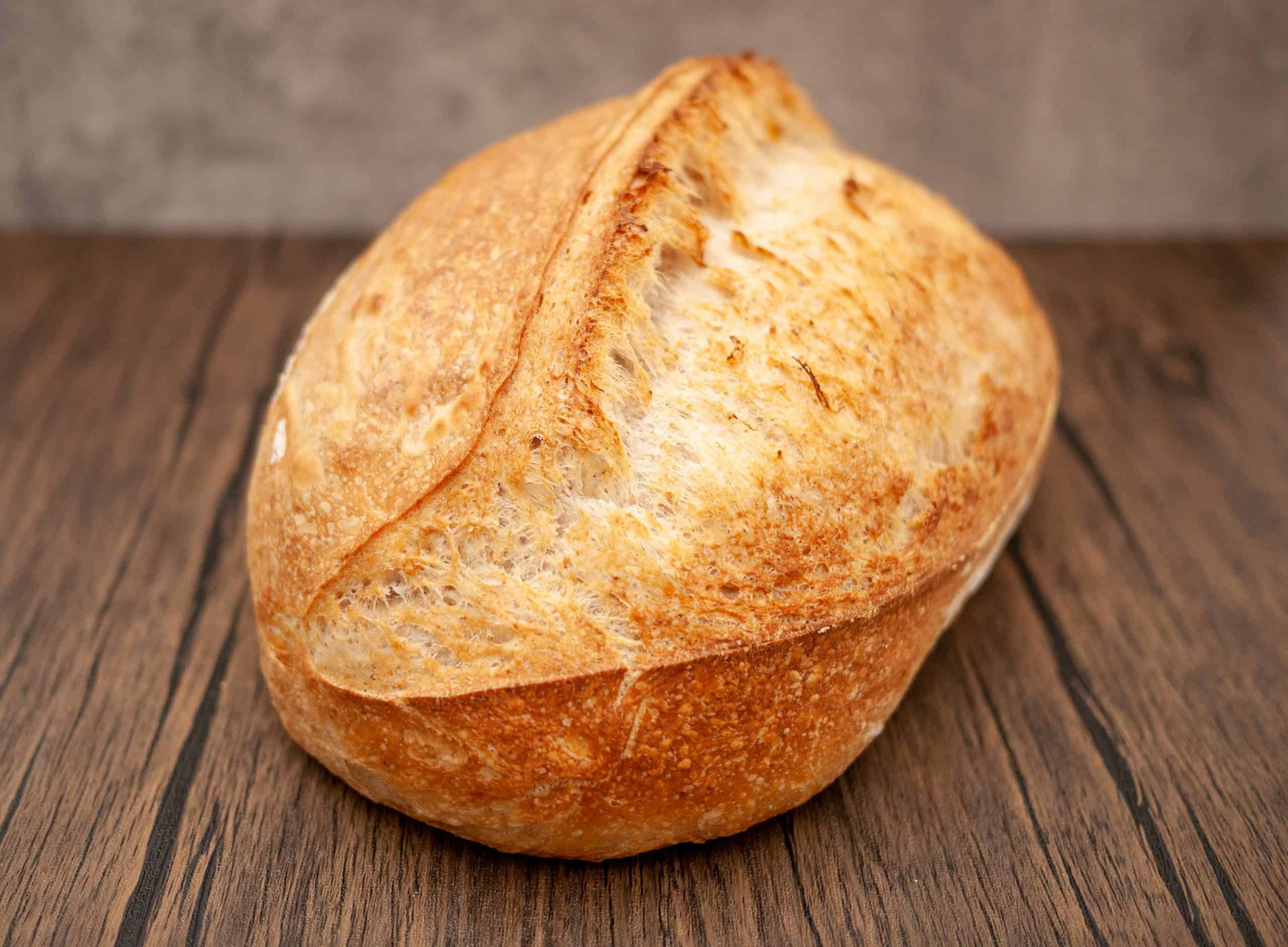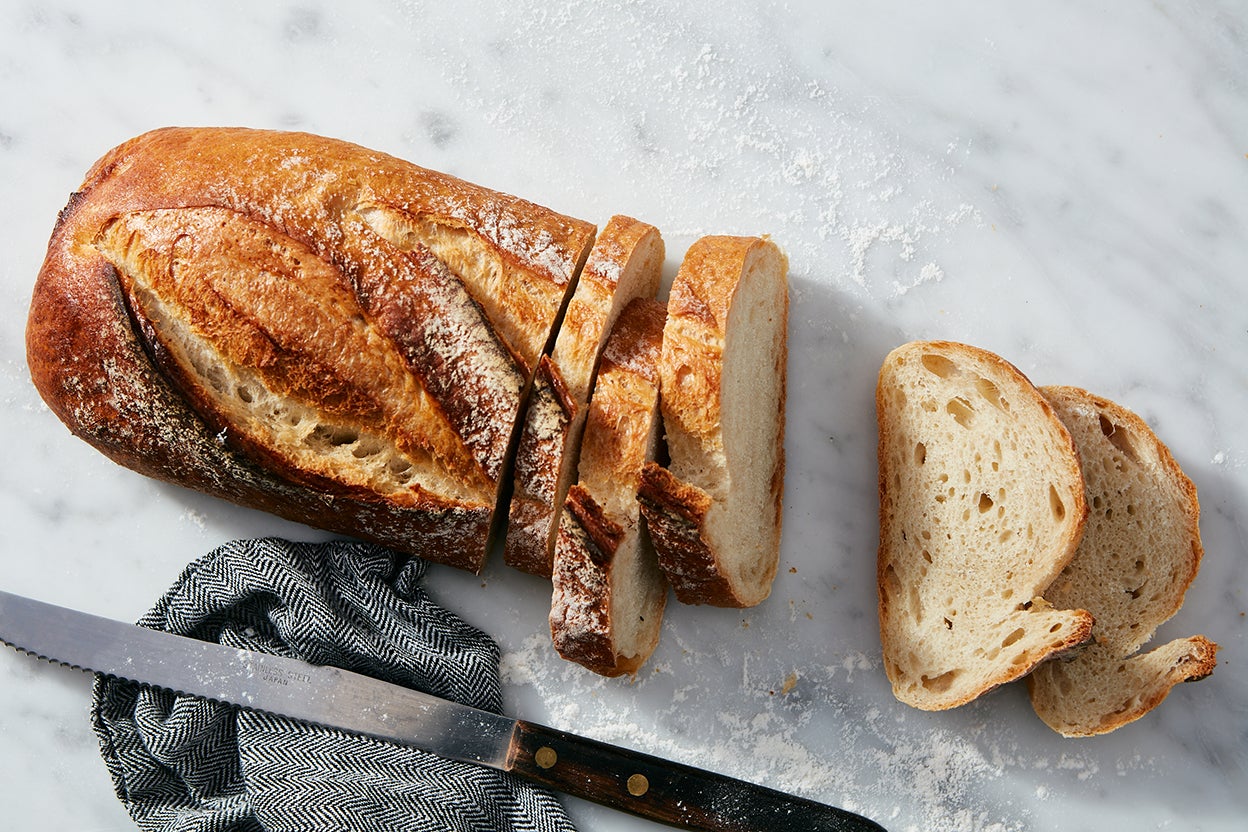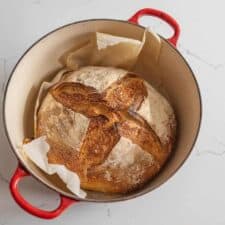This basic go-to sourdough bread recipe creates the perfect crusty on the outside, tender on the inside loaf thats just waiting to be sliced, toasted, and slathered with butter and jam!
I love this simple sourdough bread recipe because it generates the best flavor and texture, and its sure to please everyone in your home. This is one of those heart-filling recipes for sure.
I cant believe Im finally sharing my sourdough recipes with you! I planned on doing a bunch of these staple recipes this fall when everyone was feeling like baking again, but now that we are all baking together at home, this is the perfect time for me to get this helpful information into your hands. Plus … is there anything better than a crusty piece of sourdough bread with a generous spread of butter on top? I think not.
Im here to tell you that sourdough bread baking does NOT need to be fussy or overly complicated. My method for sourdough baking does not include hydration rations, creating an autolyze, or any equipment that isnt necessary. Its simple and easy for anyone to get a handle on.
When I first started making sourdough bread, I spent a MONTH trying a million recipes and failing over and over again (I made 7 loaves over one week until I got ONE that was kinda right). I just didnt understand enough and they were too fussy, and you know thats not my style. I tell you that for a few reasons. If it takes you more than one loaf of bread to get it perfect, thats normal, but you also shouldnt fail for a month trying, and Im here to help prevent that.

Sourdough Bread: A Beginner’s Guide

This beginner sourdough recipe is perfect for bakers looking to jump right in! It’s is a low-hydration dough, meaning it will yield a ‘tight’ crumb (small holes). It is great for sandwiches and toast.
Prep: 13h
Total: 14h
Yield: 1
Ingredients:
- 150g/ 5.35 oz bubbly, active sourdough starter
- 250g/ 8.80 oz warm water, preferably filtered*
- 25g/ .90 oz olive oil
- 500g/ 17.65 oz bread flour (not all purpose flour)
- 10g/ .4 oz fine sea salt
- fine ground cornmeal, for dusting
Instruction:
- After the dough has rested, work the dough in the bowl into a rough ball, about 15 seconds.
- Cover the bowl with wrap or a very damp kitchen cloth. Let rest in a warm spot to rise. The dough is ready when it no longer looks dense and has doubled in size. This can take anywhere from 3-12 hours depending on the temperature of your ingredients, the potency of your starter and surrounding environment. For example, in the summer rise times can take anywhere between 2-4 hours @ 85º F/ 29º C whereas in the winter, the dough will take about 10-12 hours @ 68º F/ 20º C.
- During bulk rise, you have the option to perform a series of ‘stretch & folds’ to strengthen the dough. Start 30 minutes into the bulk rise. Gather a portion of the dough, stretch it upwards and then fold it over itself. Rotate the bowl ¼ turn and repeat this process until you have come full circle to complete 1 set. Do this once or twice spaced about an hour apart. Although this step is not mandatory, it will increase the total volume and height of your bread. Click here for a step-by-step video tutorial.
- Then flip the dough over and place it seam side down. Using your hands, gently cup the sides of the dough and rotate it, using quarter turns in a circular motion. You can also pull it towards you to even out the shape. Repeat this process until you are happy with its appearance. *See note below.
- Preheat your oven to 450º F/ 232º C towards the tail end of the second rise.
- Right before your bread goes into the oven, make a shallow slash about 2-3 inches long (or more) in the center of the dough. Use a bread lame, sharp pairing or a small serrated steak knife. The cut should be about 1/4-inch deep.
- Remove the bread from the oven, and cool on a wire rack for at least an hour before slicing. Don’t cut too soon or else the inside will have a gummy texture!
Rustic Sourdough Bread

This chewy loaf has rich, deep, flavor with mild sourdough tang. Since it includes commercial yeast as well as starter, you’re guaranteed a good, strong rise — even if your starter isn’t quite up to snuff.
Prep: 12min
Total: 3h7min
Yield: 16 per loaf
Serving Size: 1 slice
Nutrition Facts: servingSize 1 slice, calories 80 calories, Carbohydrate 17g, Cholesterol 0mg, Fiber 1g, Protein 3g, Sodium 180mg, Sugar 1g, Fat 0g, Saturated Fat 0g, Trans Fat 0g
Ingredients:
- 1 cup (227g) ripe (fed) sourdough starter
- 1 1/2 cups (340g) water lukewarm
- 1 to 2 teaspoons instant yeast*
- 2 1/2 teaspoons (15g) salt
- 5 cups (600g) King Arthur Unbleached All-Purpose Flour
Instruction:
Weigh your flour; or measure it by gently spooning it into a cup, then sweeping off any excess. Combine all of the ingredients, kneading to form a smooth dough., Allow the dough to rise, in a lightly greased, covered bowl, until it’s doubled in size, about 90 minutes., Gently divide the dough in half; it’ll deflate somewhat. Preshape each piece of dough by pulling the edges into the center, turning it over so the seam is on the bottom, and rolling under your cupped hands to form a ball. Let the dough rest, covered, for 15 minutes., To make fat oval loaves, elongate each ball of dough you’ve preshaped by gently rolling it back and forth on an unfloured work surface several times. For longer loaves, continue rolling until they’re about 10″ to 11″ long. , Place the loaves on a lightly greased or parchment-lined baking sheet. Cover and let rise until very puffy, about 1 hour. Towards the end of the rising time, preheat the oven to 425°F. , Spray the loaves with lukewarm water and dust generously with flour., Make two fairly deep diagonal slashes in each; a serrated bread knife wielded firmly or a lame, works well here., Bake the bread for 25 to 30 minutes, until it’s a very deep golden brown. Remove it from the oven, and cool on a rack.
Easy Sourdough Bread Recipe

This basic go-to sourdough bread recipe creates the perfect crusty on the outside, tender on the inside loaf that’s just waiting to be sliced, toasted, and slathered with butter and jam!
Prep: 10min
Total: 14h
Yield: 1
Nutrition Facts: servingSize None, calories 165 calories, Sugar 0.1 g, Sodium 327.1 mg, Fat 0.7 g, Saturated Fat 0.1 g, Trans Fat 0 g, Carbohydrate 33.5 g, Fiber 2.2 g, Protein 6 g, Cholesterol 0 mg
Ingredients:
- 50 grams active starter (1/4 cup)
- 350 grams warm water (1 1/3 cups + 2 tablespoons)
- 500 grams all-purpose or bread flour (4 cups and 2 tablespoons)
- 10 grams salt (1 1/2 teaspoons)
Instruction:
- The day that you’d like to make your bread, feed your starter. I like to feed mine the morning before I plan to make my dough or at least a few hours before. Your starter will be ready to use when it is at its peak and before it starts to shrink back down in size.
- To make your bread dough, measure out your active sourdough starter into a medium mixing bowl.
- Add the water, and stir well with a fork to combine well.
- Add the flour and salt, and use the fork to combine the mixture well. It will won’t look like like bread dough yet; just stir it well to combine and that’s good enough.
- Cover the bowl with a damp kitchen towel, and let rest for 1 hour at room temperature.
- After an hour, use your hands to gently pull the edge of the dough near the side of the bowl and push it down into the middle of the bowl. Do this, rotating round the bowl, until the dough starts to look like bread dough and comes together in more of a ball. This should take about a minute of going round the bowl 2 to 3 times pulling and tucking into the center.
- Cover the bread dough with a damp kitchen towel and let it rise for 8 to 10 hours at room temperature. This is known as the bulk rise. I typically let mine rise overnight.
- After the bulk rise, gently remove the dough from the bowl onto a lightly floured surface. Tuck the edges of the dough into the center and work around the edges until you’ve tucked them all in. Flip the ball dough over. Let it rest for 5 to 10 minutes.
- Using your hands, gently pull the dough ball towards you, letting its grip on the counter pull it into a tighter ball. Rotate the dough slightly and repeat around the edges until you’ve formed a tight ball (if this is confusing, watch the video on the post where I demonstrate how to do this! It’s not hard once you see it done once).
- Prepare a bread proofing basket by dusting it well with flour (if it’s new, you’ll need to season it by spraying it with a little water and then adding the flour so it sticks), or you can use a medium mixing bowl (about 8 inches across). To prepare the mixing bowl, you’ll want to coat it generously with cooking spray and then flour very well, or you can line it with a kitchen towel and dust it very well with flour.
- Place your dough ball, smooth top down, into your prepare basket or bowl, and cover with a damp towel.
- Let the dough rest for 1 to 2 hours, at room temperature, or until it’s spread out a bit and looks puffy.
- Preheat the oven to 450 degrees F.
- Gently turn your bread dough out onto a piece of parchment paper (I like to put my parchment paper on top of a thin cutting board, put the paper and board on top of my bread basket, and turn it over gently).
- Remove the dough from the bowl. Score the top with a lame, or sharp knife (serrated knife works, too).
- Use the corners of the parchment paper to lift the dough into your dutch oven. Place the lid on the dutch oven.
- Place the dutch oven in the hot oven and cook for 30 minutes.
- Remove the lid and put the dutch oven back in the oven, uncovered, for another 20 to 30 minutes.
- The bread will be very dark and sound hollow when tapped when it is done.
- Remove the pan from the oven, and then remove the bread from the pan and let it cool on a wire rack for 1 hour before slicing and serving.
- Sourdough bread is best eaten the day of, though leftovers make great toast or grilled sandwiches.
Amazing Sourdough Bread Recipe
FAQ
What is the secret to good sourdough bread?
- Maintain your starter at a higher hydration level (more yoghurt consistency) and feed / refresh it (more) regularly. …
- Acid-producing bacteria like whole grain flours, so use less of them and more (finer / white) bread flour.
- Keep your culture at room temperature. …
- Try to speed up proofing times.
Why is sourdough bread better for you than regular bread?
Why is sourdough bread not fattening?
What is the best flour for sourdough bread?
